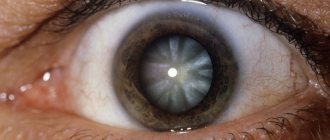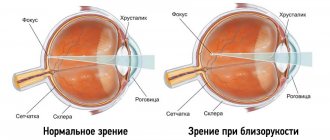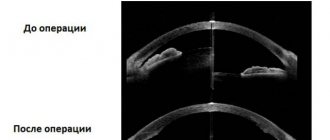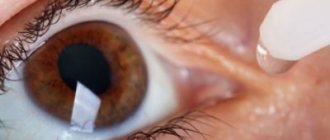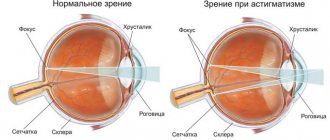Cataract, probably the only eye disease, has a huge variety of forms. But all this variety of cataracts is divided into only 2 groups: congenital pathology and acquired.
Types of congenital cataracts account for more than 50% of all congenital visual anomalies. The development of cataracts can occur in one eye or in both eyes, and can be combined with other pathologies. Congenital cataracts of the eye, as a rule, are limited in area and do not tend to progress.
Acquired cataract, on the contrary, has a progressive course and is the most common among all cases of lens opacities.
In ophthalmology, acquired cataracts are usually divided according to the reasons for their development, degree of maturity and localization.
CLASSIFICATION OF CATARACTS BY REASONS OF APPEARANCE:
Age-related cataract
The so-called senile and cyanotic cataracts begin to develop at the age of 40-45 and are the most common in ophthalmological practice. From this age, almost every sixth person has mild clouding of the lens. By the age of 80, almost every patient has a change in the transparency of the lens. This type of cataract is explained by natural aging of the body, lack of nutrients and vitamins, and attacks by general endocrine and systemic disorders in the body that occur with age. Senile cataracts are characterized by a slow rate of development, so in the early stages the patient experiences almost no visual impairment.
Cataract as a complication (complicated)
This type of disease develops in the presence of certain ophthalmological disorders. The risk group includes people with a high degree of myopia, as well as patients with glaucoma and retinal degeneration. Cataracts can also develop after inflammatory diseases of the eye, for example, uveitis.
Radiation cataract
This type develops due to prolonged exposure to rays on the lens. These can be ultraviolet, infrared, x-rays, as well as radiation. The risk group includes people whose profession is characterized by constant contact with such radiation.
Traumatic cataract
Occurs after mechanical damage to the eye (penetrating trauma, blunt injury).
Medicinal cataract
This type of disease develops as a result of the use, abuse or misuse of certain drugs. Patients taking steroid hormones, corticosteroids, tricyclic antidepressants, chlorpromazine, amiodarone, gold preparations, allopurinol for a long time are especially at risk. The use of antimalarial and antiepileptic drugs also puts the patient at risk.
Exchange cataract
Develops due to metabolic disorders, diseases of the endocrine system, nodes on the thyroid gland, etc. Patients with diabetes mellitus, autoimmune diseases, and atopic dermatitis are at risk.
Standard methods for diagnosing cataracts
Once the specialist has determined that the patient may have cataracts, standard or routine diagnostic procedures are prescribed. These include determination of visual acuity or visometry, which usually confirms a decrease in visual acuity. Also, using the method of diagnosing cataracts, perimetry checks the visual field and evaluates the parameters of its binocular functions.
It is worth noting that intraocular pressure factors are not always taken into account when diagnosing cataracts, since they are not a sign of the development of the disease. However, tonometry is prescribed to exclude other diseases. A study of entopic visual phenomena is being carried out, which makes it possible to identify pathologies of the retina and optic nerve.
Then the anterior segment of the eye is diagnosed using a slit lamp or biomicroscopy. In this case, it is possible to determine opacities in the lens and, based on a visual examination, give a conclusion about the presence or absence of this disease.
CLASSIFICATION OF CATARACTS BY LOCATION
Cataracts localized in one zone have little effect on visual acuity; the eye quickly adjusts and gets used to seeing through unclouded areas. However, with the development of new affected areas, the symptoms become stronger, then the clouded parts of the lens merge, which leads to a rapid deterioration of the patient’s condition.
Types of cataracts by localization: nuclear cataract, cortical cataract, mixed cataract.
Depending on the complexity of the case, an expanded classification is used:
- Anterior or posterior polar cataract (clouding is localized at the anterior or posterior pole of the lens, is characteristic of a congenital disease, has little effect on vision)
- fusiform cataract (opacities are localized in the center, but have little effect on vision and progress slowly)
- layered (zonular) cataract (opaque and clear layers of the lens alternate)
- nuclear cataract (starts from the nucleus of the lens)
- cortical (cortical) cataract (starts from the cortex of the lens, characteristic of senile cataracts)
- posterior subcapsular cataract (progresses quickly, vision rapidly decreases)
- total (complete) cataract (complete clouding of the lens, often bilateral, characteristic of a congenital disease)
Stage of initial cataract
In children and young people, the lens is normally completely transparent, sometimes with a bluish-grayish tint. With age, it becomes denser, sclerosed and acquires a yellowish tint. This condition is called phacosclerosis. There is a hypothesis that the biological lens thereby protects the retina from harmful ultraviolet rays that can cause age-related degenerative retinal changes.
| Often, during an examination in a clinic, an ophthalmologist mistakes the yellowish tint of phacosclerosis for senile initial cataracts. |
This explains the frequency of this diagnosis in patients aged 50 years.
True senile primary cataract is characterized by opacities that are clearly visible when examined at a slit lamp or in transmitted light. They are either insignificant in size or are located on the periphery of the organ, outside the optical axis, often spoke-shaped with the apex towards the center.
The initial changes also include symptoms of hydration of the lens: vacuoles (bubbles with liquid), water gaps and separation of the lens fibers.
The patient will not be able to see all these changes in himself, and complaints with cataracts in the initial stage may be absent. Some sources contain information that visual acuity at this stage of the disease decreases to the first - top - line on the vision test table. This is wrong.
| A patient with senile primary cataracts without concomitant ocular pathologies and refractive errors can see from 7 to 10 lines (visus = 0.7-1.0). |
Age-related, or, according to ICD-10, senile cataracts in the initial stage may be asymptomatic or accompanied by the following complaints:
- blurred image, unclear contours of objects;
- the appearance of a halo around light sources - light bulbs, lanterns, car headlights;
- reduced contrast and color rendering;
- feeling of “dirty” glasses;
- difficulties when working with small text or details, while increasing the diopter of the glasses does not add clarity.
Often, senile primary cataracts are attributed to the sensation of flashing black dots - “floaters” before the eyes. Such symptoms are rather characteristic of the destruction of the vitreous body, a gel-like substance located behind the lens.
CLASSIFICATION OF CATARACTS BY DEGREE OF MATURITY
- initial cataract (the central part of the lens and its nucleus are untouched for a long time, vision decreases very slowly and imperceptibly, the patient may complain of a feeling of a film in the eyes or small dots in the image)
- immature cataract (damage to the lens moves to the central zone, vision decreases quickly)
- mature cataract (the lens is almost completely cloudy, the patient can only distinguish degrees of light intensity, the image is almost completely absent)
- overripe cataract (the lens disintegrates, its nucleus descends, the patient goes blind. There is a risk of developing glaucoma due to the fact that remnants of the lens can penetrate into the eye cavity)
What is a cataract?
Cataract - a thickening inside the lens
A cataract is a dense structure that forms inside the lens of the eye. The disease is characterized by the accumulation of special proteins inside the lens, preventing the penetration of light.
This process leads to disruption of visual perception, since the lens must direct light rays to the retinal area. The pathology develops quite slowly, often over several years.
Severe visual impairment does not develop immediately, usually after a fairly long asymptomatic period. Cataracts can occur in one eye or in both eyes at once. This disease is most common among older people.
Cataracts are one of the leading causes of blindness among older people. Vision loss due to cataracts is usually reversible, but the problem lies in late detection of the disease.
For patients at risk, it is important to conduct ongoing eye examinations. Timely medical intervention can often save vision.
Functions of the lens
Vision is an important function
The lens is an important structure of the eyeball, providing the optical properties of vision. Light rays passing through the lens change their direction and excite the retinal receptor apparatus.
From the retina, visual information enters the brain. Without the refractive properties of the lens, vision as a whole is impossible.
The lens is located in the front of the eyeball. This translucent structure is capable of changing its shape due to the muscle fibers associated with it. Changing the shape of the lens ensures that vision is focused on near and far objects.
In its normal state, the lens has an ellipsoidal, biconvex shape. Overall, the structure is similar to an elongated sphere. The structure of the lens consists of epithelial tissue, capsule and special fibers.
The capsule forms the smooth outer layer of the lens, and the fibers are long, spindle-shaped structures that form the bottom of the lens. The epithelium is responsible for the preservation of the functions of the lens.
Risk factors
In addition to learning about the causes of cataract development, it is important to know about the risk factors that contribute to the development of the disease. These include:
- Age over 50 years.
- Drinking strong alcoholic drinks.
- Long-term smoking.
- Obesity.
- High blood pressure.
- Trauma to the eyeball.
- Family history of cataracts.
- Constant exposure to sunlight.
- Diabetes.
- Radiation therapy.
The listed factors may not directly provoke the development of the disease, but increase the chance of cataracts.
Causes and symptoms of cataracts
What is a cataract?
The causes of the disease may vary depending on the type of cataract. However, there are the following main etiological factors:
- Excessive release of cellular oxidants. Oxidizing agents are formed by an oxygen molecule in active form. These molecules are capable of damaging various cells and tissues.
- Smoking.
- Prolonged exposure to ultraviolet radiation.
- Long-term use of steroid drugs.
- Various diseases affecting the functioning of the visual system.
- Diabetes.
- Eye injury.
- Impact of radiation therapy.
- Age-related changes in the lens.
The symptomatic manifestations of cataracts vary. Often the pathology develops asymptomatically for several years and subsequently begins to manifest itself as a decrease in visual acuity.
Main symptoms:
- Marked decrease in visual acuity. This is the most common complaint of patients with cyanide cataracts.
- Impaired perception of light. May range from decreased contrast sensitivity to severe opacification.
- Development of monocular diplopia. In this case, the patient sees several images of one object. The pathology is associated with changes in the inner layers of the central part of the lens. Monocular diplopia cannot be corrected with glasses or contact lenses.
- Impaired vision focusing.
- Deterioration of night vision.
- Constant glare.
If these symptoms appear, you should consult an ophthalmologist, since many cataract symptoms are quite specific.
Types of cataracts
Cataract - examination
Doctors distinguish several types of cataracts, based on the characteristics of the course and origin of the disease:
- Median cataract. This type of cataract affects the middle part of the lens, changing the color of the structure to yellow or brown.
- Cortical cataract. This is a peripheral type of pathology, which is characterized by the appearance of wedge-shaped structures around the nucleus of the lens.
- Posterior capsular cataract. This type of cataract forms quite quickly and primarily affects the back of the lens.
- Congenital cataract. The pathology develops during the prenatal period. In newborns, there is a decrease in visual acuity.
- Secondary cataract. This type of cataract is usually associated with other medical conditions and medications. Secondary cataracts can develop in response to glaucoma or diabetes. Taking prednisolone and other steroid drugs can also lead to the development of this pathology.
- Traumatic cataract. Develops in response to eye injury. Often, clouding of the lens is observed several years after the injury.
- Radiation cataract. This type of illness is a side effect of radiation therapy.
- Age-related cataract. It usually forms after 50 years and is associated with age-related changes in the structures of the eyeball.
Doctors are not always able to identify the type of cataract in a particular patient.
Development mechanism
Cataracts affect vision
The pathophysiology of cataracts is complex and not well understood. In all likelihood, the course of the disease is influenced by the interaction of several factors.
Scientists note the importance of environmental, genetic, nutritional and systemic factors in the mechanism of cataract development. As the lens develops with age, certain structures change.
New cortical layers forming around the nucleus of the lens gradually shrink and harden. This process is called sclerosis of the lens nucleus.
Various pathological mechanisms contribute to the gradual loss of lens transparency. It is believed that the lens epithelium is subject to age-related changes and, in particular, a decrease in cell density. These processes affect the plasticity of the lens.
In addition, the transport of water, nutrients and antioxidants into the lens deteriorates with age. As a result, progressive oxidative damage to the structure occurs, leading to the development of cataracts.
Another important factor is protein abnormalities. Small soluble protein molecules in the lens gradually turn into large insoluble aggregates. This process sharply reduces the transparency of the lens and also worsens the refractive properties of the structure.
